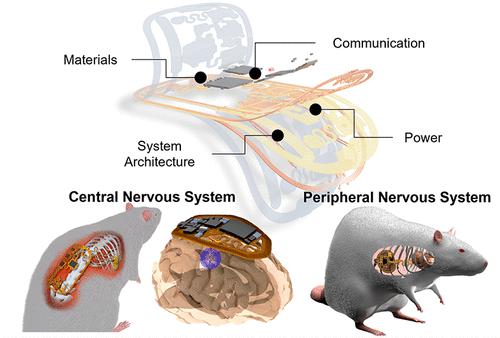当前位置:
X-MOL 学术
›
Acc. Chem. Res.
›
论文详情
Our official English website, www.x-mol.net, welcomes your feedback! (Note: you will need to create a separate account there.)
Monolithically Defined Wireless Fully Implantable Nervous System Interfaces
Accounts of Chemical Research ( IF 18.3 ) Pub Date : 2024-04-12 , DOI: 10.1021/acs.accounts.4c00013 Philipp Gutruf 1
Accounts of Chemical Research ( IF 18.3 ) Pub Date : 2024-04-12 , DOI: 10.1021/acs.accounts.4c00013 Philipp Gutruf 1
Affiliation

|
Evolution of implantable neural interfaces is critical in addressing the challenges in understanding the fundamental working principles and therapeutic applications for central and peripheral nervous systems. Traditional approaches utilizing hermetically sealed, rigid electronics and detached electrodes face challenges in power supply, encapsulation, channel count, dispersed application location, and modality. Employing thin-film, wirelessly powered devices is promising to expand capabilities. Devices that forego bulky power supplies, favoring a configuration where electronics are integrated directly onto thin films, reduce displacement volumes for seamless, fully implantable interfaces with high energy availability and soft mechanics to conform to the neuronal target. We discuss 3 device architectures: (1) Highly miniaturized devices that merge electronics and neural interfaces into a single, injectable format; (2) Interfaces that consolidate power, computation, and neural connectivity on a thin sheet applied directly to the target area; (3) A spatially dislocated approach where power and computation are situated subdermally, connected via a thin interconnect to the neural interface.Each has advantages and constraints in terms of implantation invasiveness, power capturing efficiency, and directional sensitivity of power delivery. In powering these devices, near-field power delivery emerges as the most implemented technique. Key parameters are size and volume of primary and secondary antennas, which determine coupling efficiency and power delivery. Based on application requirements, ranging from small to large animal models, subjects require system level designs. Material strategies play a crucial role; monolithic designs, with materials like polyimide substrates, enable scalability with high performance. This contrasts with established hermetic encapsulation approaches that use a stainless steel or titanium box with passthroughs that result in large tissue displacements and prohibit intimate integration with target organ systems. Encapsulation, particularly with parylene, enables longevity and effectiveness; more research is needed to enable human lifetime operation. Implant-to-ambient device communication, focusing on strategies compatible with well-established standards and off-the-shelf electronics, is discussed with the goal of enabling seamless system integration, reliability, and scalability. The interface with the central nervous system is explored through various wireless, battery-free devices capable of both stimulation (electrical and optogenetic) and recording (photometric and electrochemical). These devices show advanced capabilities for chronic studies and insights into neural dynamics. In the peripheral nervous system, stimulation devices for applications, such as spinal and muscle stimulation, are discussed. The challenges lie in the mechanical and electrochemical durability. Examples that successfully navigate these challenges offer solutions for chronic studies in this domain. The potential of wireless, fully implantable nervous system interfaces using near field resonant power transfer is characterized by monolithically defined device architecture, providing a significant leap toward seamless access to the central and peripheral nervous systems. New avenues for research and therapeutic applications supporting a multimodal and multisite approach to neuromodulation with a high degree of connectivity and a holistic approach toward deciphering and supplementing the nervous system may enable recovery and treatment of injury and chronic disease.
中文翻译:

单片定义的无线完全植入神经系统接口
植入式神经接口的发展对于解决理解中枢和周围神经系统的基本工作原理和治疗应用的挑战至关重要。利用密封、刚性电子器件和分离电极的传统方法面临电源、封装、通道数、分散应用位置和模式方面的挑战。采用薄膜无线供电设备有望扩展功能。放弃笨重电源的设备,倾向于将电子设备直接集成到薄膜上的配置,减少位移量,实现无缝、完全可植入的接口,具有高能量可用性和软机械结构,以符合神经元目标。我们讨论 3 种设备架构:(1) 高度小型化的设备,将电子设备和神经接口合并为单一可注射格式; (2) 将功率、计算和神经连接整合到直接应用于目标区域的薄片上的接口; (3) 一种空间错位方法,其中功率和计算位于皮下,通过细互连连接到神经接口。每种方法在植入侵入性、功率捕获效率和功率传输的方向敏感性方面都有优点和限制。在为这些设备供电时,近场供电成为最常用的技术。关键参数是主天线和副天线的尺寸和体积,它们决定耦合效率和功率传输。根据应用需求,从小动物模型到大型动物模型,受试者需要系统级设计。物质策略发挥着至关重要的作用;采用聚酰亚胺基板等材料的单片设计可实现高性能的可扩展性。这与现有的密封封装方法形成鲜明对比,后者使用带有通道的不锈钢或钛盒,导致大量组织移位并阻止与目标器官系统的紧密结合。封装,尤其是聚对二甲苯封装,可实现长寿命和有效性;需要更多的研究来实现人类终生运行。讨论了植入物到环境设备的通信,重点是与既定标准和现成电子设备兼容的策略,其目标是实现无缝系统集成、可靠性和可扩展性。通过各种能够刺激(电和光遗传学)和记录(光度和电化学)的无线、无电池设备来探索与中枢神经系统的接口。这些设备展示了长期研究和神经动力学洞察的先进能力。在周围神经系统中,讨论了用于脊柱和肌肉刺激等应用的刺激装置。挑战在于机械和电化学耐久性。成功应对这些挑战的例子为该领域的长期研究提供了解决方案。使用近场谐振功率传输的无线、完全植入式神经系统接口的潜力以单片定义的设备架构为特征,为无缝访问中枢和周围神经系统提供了重大飞跃。研究和治疗应用的新途径支持多模式和多部位的神经调节方法,具有高度的连接性和破译和补充神经系统的整体方法,可能有助于损伤和慢性疾病的恢复和治疗。
更新日期:2024-04-13
中文翻译:

单片定义的无线完全植入神经系统接口
植入式神经接口的发展对于解决理解中枢和周围神经系统的基本工作原理和治疗应用的挑战至关重要。利用密封、刚性电子器件和分离电极的传统方法面临电源、封装、通道数、分散应用位置和模式方面的挑战。采用薄膜无线供电设备有望扩展功能。放弃笨重电源的设备,倾向于将电子设备直接集成到薄膜上的配置,减少位移量,实现无缝、完全可植入的接口,具有高能量可用性和软机械结构,以符合神经元目标。我们讨论 3 种设备架构:(1) 高度小型化的设备,将电子设备和神经接口合并为单一可注射格式; (2) 将功率、计算和神经连接整合到直接应用于目标区域的薄片上的接口; (3) 一种空间错位方法,其中功率和计算位于皮下,通过细互连连接到神经接口。每种方法在植入侵入性、功率捕获效率和功率传输的方向敏感性方面都有优点和限制。在为这些设备供电时,近场供电成为最常用的技术。关键参数是主天线和副天线的尺寸和体积,它们决定耦合效率和功率传输。根据应用需求,从小动物模型到大型动物模型,受试者需要系统级设计。物质策略发挥着至关重要的作用;采用聚酰亚胺基板等材料的单片设计可实现高性能的可扩展性。这与现有的密封封装方法形成鲜明对比,后者使用带有通道的不锈钢或钛盒,导致大量组织移位并阻止与目标器官系统的紧密结合。封装,尤其是聚对二甲苯封装,可实现长寿命和有效性;需要更多的研究来实现人类终生运行。讨论了植入物到环境设备的通信,重点是与既定标准和现成电子设备兼容的策略,其目标是实现无缝系统集成、可靠性和可扩展性。通过各种能够刺激(电和光遗传学)和记录(光度和电化学)的无线、无电池设备来探索与中枢神经系统的接口。这些设备展示了长期研究和神经动力学洞察的先进能力。在周围神经系统中,讨论了用于脊柱和肌肉刺激等应用的刺激装置。挑战在于机械和电化学耐久性。成功应对这些挑战的例子为该领域的长期研究提供了解决方案。使用近场谐振功率传输的无线、完全植入式神经系统接口的潜力以单片定义的设备架构为特征,为无缝访问中枢和周围神经系统提供了重大飞跃。研究和治疗应用的新途径支持多模式和多部位的神经调节方法,具有高度的连接性和破译和补充神经系统的整体方法,可能有助于损伤和慢性疾病的恢复和治疗。



























 京公网安备 11010802027423号
京公网安备 11010802027423号